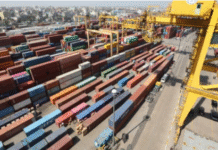
The share of women working in Bangladesh’s garment industry decreased over the past decade, with female participation falling to 53 percent in 2023 from 56 percent in 2014, according to a recent study.
It attributed the changes in the distribution of female workers across different segments of the country’s main export earning sector to their increased presence in home textile and woven industries.
However, there was a significant decline in the female participation rate in jacket-making industries, it added.
Kazi Iqbal, research director of the Bangladesh Institute of Development Studies (BIDS), shared these findings at an annual development conference organised by BIDS at the Lakeshore Hotel in Dhaka yesterday.
The study, titled “Technology Upgradation of the RMG Industries in Bangladesh”, noted that women made up more than 80 percent of the garment sector’s workforce during its initial development.
Although this trend prevailed for many years, female participation in garment industries started declining amid a growing reluctance to engage in laborious factory work.
The study also found that second-generation workers are less interested in joining the garments sector.
Besides, the overall number of garment workers decreased over time as professions such as machine operators and their helpers have become obsolete thanks to mechanisation.
On the other hand, the number of factory supervisors and management personnel remained mostly unchanged.
Furthermore, the study informed that an average of between 4.13 and 2.15 workers lost their jobs for each $1 million spent on purchasing new equipment.
But although modern technology enabling automation is displacing labour, such innovations are creating new opportunities for employment, the study said.
Additionally, the study pointed out that the growing capabilities of local firms propelled automation in recent years, reducing the need for labourers to operate machinery.
There was also evidence that the reduction in female participation could have resulted from gender-biased technological transitions for occupations like machine operators.
Moderated by Sajjad Zohir, executive director of the Economic Research Group, a total of four studies were shared at the session.
Presenting a paper on “Supply Chain Dynamics for Sustainable RMG Growth in Bangladesh”, BIDS Research Director Monzur Hossain said the European Union (EU) offers tariff protection for least developed countries (LDC) following their graduation to developing country status.
This includes import subsidies of about 4 percent for fabrics, 8 percent for semi-finished garments and 12 percent for clothing sourced from “Most-Favoured Nations”.
In the post-LDC era, Bangladesh may face tariffs as high as 9.6 percent on exports to the EU, he added.
The study also said Bangladesh may lose 10.8 percent of its garment exports by 2031 due to the elimination of export subsidies following LDC graduation.
This potential loss of export earnings could range from 7 percent to 14 percent in major markets.
For the 9.6 percent tariff in the EU, the production of textiles and apparel items for the trade bloc may decline by about 6.1 percent. So, it is possible that Bangladesh’s negative trade balance with the EU could widen, thereby impacting its gross domestic product (GDP).
As such, the country’s real GDP could contract by about 0.38 percent if developed countries start imposing tariffs, it added. This loss of duty benefits could slash Bangladesh’s total exports by about 6 percent while the apparel sector will likely witness a 14 percent decline.
A study titled “Structural Changes in Industrial Sector of Bangladesh: 2012 to 2019”, presented by BIDS Research Associate Jayed Bin Satter, said female participation has also dropped in the manufacturing sector.
Similarly, the overall share of female business leaders fell, mostly driven by their exit from the garment sector, it added.
Presenting a study on “The State of the Manufacturing Workers in Bangladesh”, BIDS Research Associate Farhin Islam said significant intergenerational effects on workers’ education were observed.
While there is a tendency for real wages to remain flat, collective bargaining has a significant impact on raising wages, improving other benefits and enhancing working conditions.
Trade unionisation significantly enhances women’s family decision-making power through stronger collective bargaining and advocacy whereas factory-level unions lack sufficient influence on women empowerment.
The poverty rate among garment workers is significantly lower than that of workers in non-garment sectors and other domestic industries with more stringent compliance requirements.
daily star









